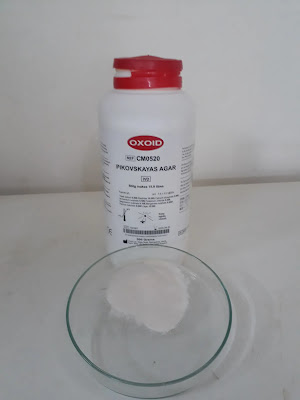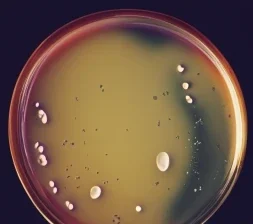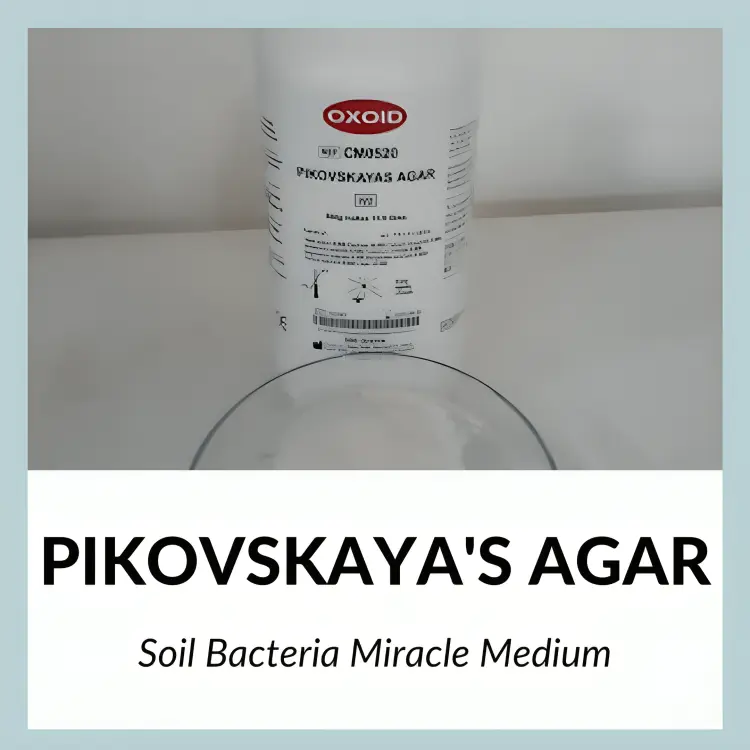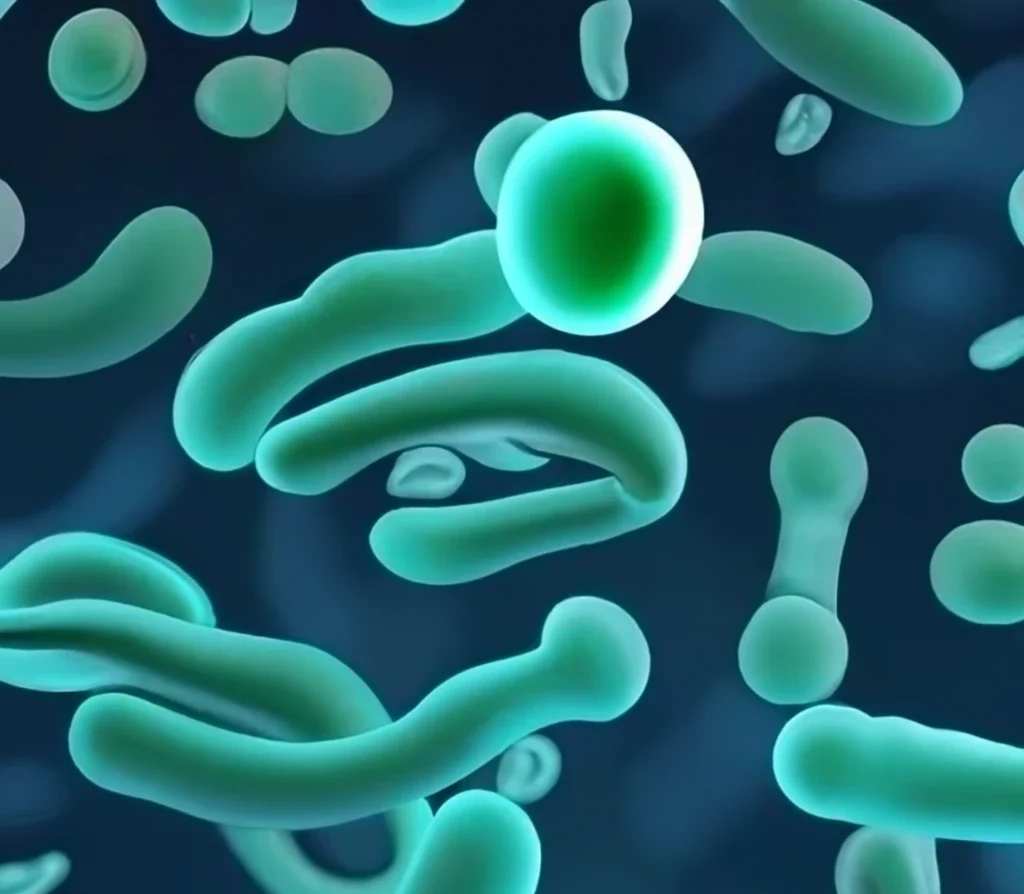As a soil microbiologist, you need to culture soil bacteria for research purposes. However, the vast majority of soil bacteria are notoriously difficult to cultivate in the laboratory, primarily due to their slow growth rates and complex nutritional requirements. In this brief post we will introduce you to Pikovskaya’s agar, a miracle medium that allows you to selectively grow a diverse range of soil bacteria. Let’s start our general informative blog.

1. What is Pikovskaya’s agar?
Pikovskaya’s agar is a nutrient-rich medium used to isolate soil bacteria, particularly those capable of utilizing insoluble forms of phosphorus, such as tricalcium phosphate. It was first developed by Russian microbiologist Nina Ivanova Pikovskaya in the 1940s.

2. The composition of Pikovskaya’s agar
Pikovskaya’s agar contains several components that are essential for the growth of soil bacteria. The key ingredients are:
- Tricalcium phosphate.
- Potassium dihydrogen phosphate.
- Magnesium sulfate.
- Ammonium sulfate.
- Yeast extract.
- Glucose.
- Agar.
3. The benefits of using Pikovskaya’s agar
The use of Pikovskaya’s agar offers several benefits, including:
- It allows for the selective isolation of soil bacteria that can utilize insoluble forms of phosphorus, such as tricalcium phosphate.
- It supports the growth of a diverse range of soil bacteria, including those that are notoriously difficult to culture.
- It is relatively inexpensive and easy to prepare.
- It can be modified to study other aspects of soil microbiology, such as carbon cycling and nitrogen fixation.
- 4. How to prepare Pikovskaya’s agar.
To prepare Pikovskaya’s agar, you will need the following:
- 0.5 g tricalcium phosphate
- 0.5 g potassium dihydrogen phosphate
- 0.2 g magnesium sulfate
- 0.1 g ammonium sulfate
- 0.5 g yeast extract
- 10 g glucose
- 15 g agar
- 1 L distilled water
To prepare Pikovskaya’s agar, follow these steps:
- Mix all the ingredients except for agar in a flask containing 1 L of distilled water.
- Adjust the pH to 7.0 using 1 N NaOH or 1 N HCl.
- Add 15 g of agar to the flask and mix well.
- Autoclave the medium for 20 minutes at 121°C.
- Pour the medium into sterile Petri dishes and let it solidify.
5. How to use Pikovskaya’s agar for bacterial isolation
- To use Pikovskaya’s agar for bacterial isolation, follow these steps:
- Collect soil samples from the desired location.
- Prepare serial dilutions of the soil samples in sterile saline.
- Plate the dilutions onto Pikovskaya’s agar plates.
- Incubate the plates at the appropriate temperature for the soil bacteria you are trying to isolate (usually between 25-30°C) for several days to several weeks.
- Look for bacterial colonies that grow on the agar plates. Soil bacteria that can utilize insoluble forms of phosphorus will typically show up as a clear zone around the colony, indicating that they have produced phosphatase enzymes that break down the tricalcium phosphate in the medium.
- Pick individual colonies and streak them onto fresh Pikovskaya’s agar plates to obtain pure cultures for further characterization.
6. Troubleshooting common problems with Pikovskaya’s agar
Some common problems that can arise when using Pikovskaya’s agar include:
- Contamination with other microorganisms: This can be minimized by properly sterilizing all equipment and materials before use and by using proper aseptic techniques when handling the samples.
- Poor growth of soil bacteria: This can be due to several factors, including low pH or nutrient limitation. Adjusting the pH of the medium and/or supplementing it with additional nutrients may help.
- No clear zone around bacterial colonies: This can indicate that the soil bacteria being tested do not produce phosphatase enzymes or that they are not active under the conditions used.
7. Other applications of Pikovskaya’s agar
In addition to its use in isolating soil bacteria that can utilize insoluble forms of phosphorus, Pikovskaya’s agar can also be modified to study other aspects of soil microbiology. For example, researchers have used modified versions of the medium to study carbon cycling, nitrogen fixation, and the diversity of soil microorganisms.
8. Limitations of Pikovskaya’s agar
While Pikovskaya’s agar is a valuable tool for studying soil bacteria, it does have some limitations. For example:
- It only selects for bacteria that can utilize insoluble forms of phosphorus, and may not be suitable for studying other types of soil microorganisms.
- It may not accurately represent the natural conditions of the soil environment, which can be highly variable and complex.
- It may not be effective for isolating all types of soil bacteria, particularly those that are very slow-growing or have unique nutritional requirements.
9. prospects of Pikovskaya’s agar
Despite its limitations, Pikovskaya’s agar remains a valuable tool for soil microbiologists. Ongoing research is focused on improving the medium’s selectivity and sensitivity, as well as developing new methods for studying soil microorganisms.

10. Conclusion
In conclusion, Pikovskaya’s agar is a valuable tool for soil microbiologists looking to culture soil bacteria. Its ability to selectively isolate bacteria that can utilize insoluble forms of phosphorus, coupled with its relative simplicity and low cost, make it an essential medium in the field. While it has some limitations, ongoing research is focused on improving its utility and expanding its applications.
11. FAQs
Q: What is the origin of Pikovskaya’s agar?
A: Pikovskaya’s agar was first developed by Russian microbiologist Nina Ivanovna Pikovskaya in the 1940s.
Q: What is the key ingredient in Pikovskaya’s agar?
A: Tricalcium phosphate is the key ingredient in Pikovskaya’s agar, as it allows for the selective isolation of bacteria that can utilize insoluble forms of phosphorus.
Q: What are some common problems that can arise when using Pikovskaya’s agar?
A: Common problems can include contamination with other microorganisms, poor growth of soil bacteria, and no clear zone around bacterial colonies.
Q: What are some potential future applications of Pikovskaya’s agar?
A: Some potential future applications of Pikovskaya’s agar include improving its selectivity and sensitivity, developing new methods for studying soil microorganisms, and adapting the medium for use in other types of environments beyond soil, such as aquatic systems. Ongoing research may also explore how Pikovskaya’s agar can be used in combination with other techniques, such as DNA sequencing and bioinformatics, to better understand the diversity and function of soil microbial communities.
Q: What is the history of Pikovskaya’s agar?
A: Pikovskaya’s agar was first described by Russian microbiologist Olga Ivanovna Pikovskaya in 1948.
Q: How is Pikovskaya’s agar different from other types of cultural media?
A: Pikovskaya’s agar contains specific ingredients that promote the growth of bacteria that can break down complex organic compounds, particularly those that contain phosphorus.
Q: Can Pikovskaya’s agar be used to study fungi?
A: No, Pikovskaya’s agar is specifically designed for bacterial growth and cannot support the growth of fungi.
Q: What types of bacteria can be grown on Pikovskaya’s agar?
A: Bacteria that are capable of phosphorus solubilization can be grown on Pikovskaya’s agar. This includes species from the genera Pseudomonas, Bacillus, and Rhizobium, among others.
Q: What are the advantages of using Pikovskaya’s agar over other types of cultural media?
A: Pikovskaya’s agar provides a simple and cost-effective way to study soil bacteria that can break down organic phosphorus compounds, which are important nutrients for plant growth.
Q: Can Pikovskaya’s agar be used to identify specific bacterial species?
A: While Pikovskaya’s agar can be used to isolate bacteria that are capable of phosphorus solubilization, additional tests are typically required to identify specific bacterial species.
Q: Can Pikovskaya’s agar be used to study the soil microbiome?
A: Yes, Pikovskaya’s agar can be used as part of a larger effort to study the diversity and function of microbial communities in soil.
Q: Is Pikovskaya’s agar safe to handle?
A: Yes, Pikovskaya’s agar is generally considered safe to handle, although appropriate safety measures should always be followed when working with any type of microbiological culture.
Q: How long does it take for bacteria to grow on Pikovskaya’s agar?
A: The growth rate of bacteria on Pikovskaya’s agar can vary depending on the specific bacterial species being studied and the environmental conditions in the culture.
Q: What are the limitations of using Pikovskaya’s agar?
A: One limitation of using Pikovskaya’s agar is that it is not suitable for studying all types of soil bacteria. Additionally, other types of culture media may be required to study other aspects of soil microbiology.
Q: Can Pikovskaya’s agar be used to study bacterial biofilms?
A: Yes, Pikovskaya’s agar can be used as part of a larger effort to study bacterial biofilms in soil and other environments.
Q: What is the role of phosphorus in plant growth?
A: Phosphorus is an essential nutrient for plant growth, playing a critical role in processes such as photosynthesis, energy transfer, and DNA synthesis.
Q: How is Pikovskaya’s agar prepared?
A: Pikovskaya’s agar is typically prepared by dissolving specific ingredients, including calcium carbonate and potassium dihydrogen phosphate, in distilled water and then sterilizing the mixture.
Q: What are some potential applications of Pikovskaya’s agar beyond soil microbiology?
A: Pikovskaya’s agar has potential applications in fields such as bioremediation and wastewater treatment, as well as in the study of microbial communities in other types of environments, such as aquatic systems.
Q: Can Pikovskaya’s agar be used to study the microbiology of other planets?
A: While Pikovskaya’s agar has primarily been used to study soil microbiology on Earth, it could potentially be adapted for use in the study of microbial communities on other planets or moons.
Q: How does Pikovskaya’s agar compare to other types of culture media for studying soil microbiology?
A: While many different types of culture media can be used to study soil microbiology, Pikovskaya’s agar is unique in that it specifically targets bacteria that are capable of breaking down organic phosphorus compounds, making it a valuable tool for researchers studying nutrient cycling in soil ecosystems.







